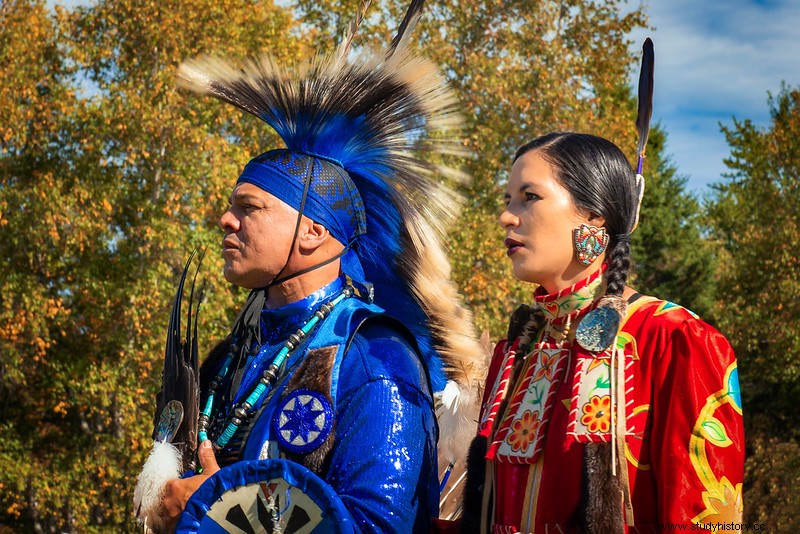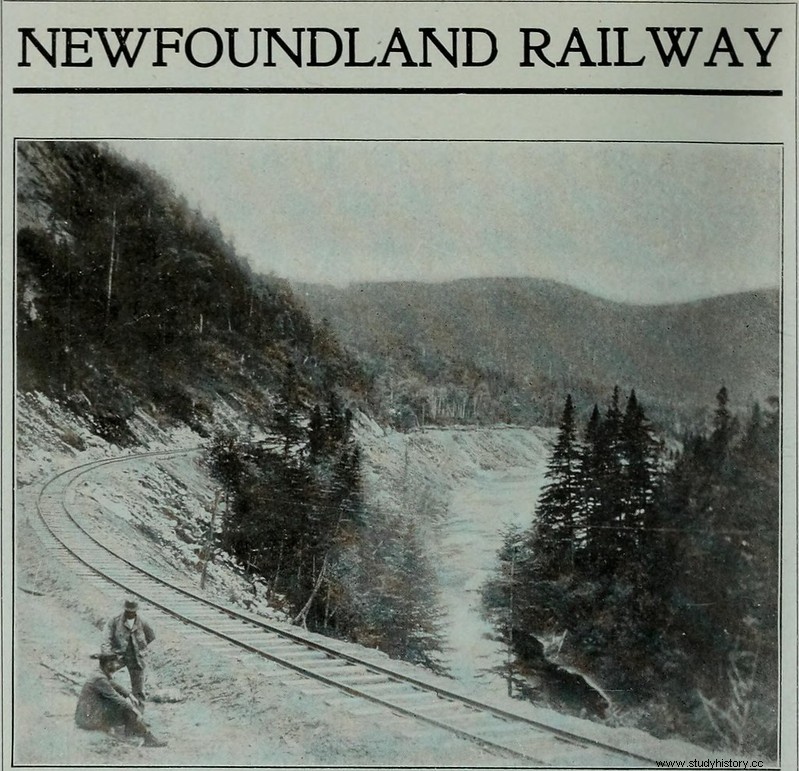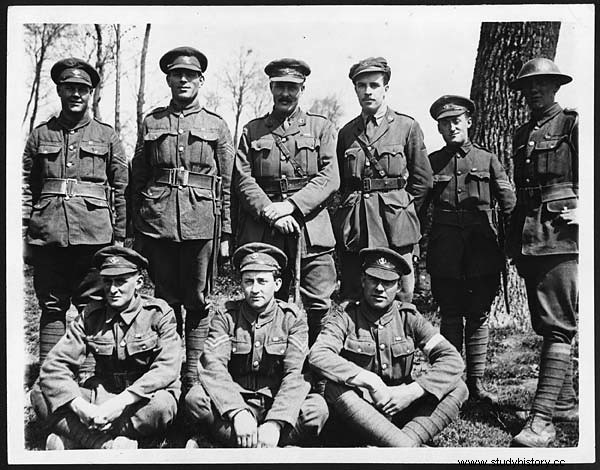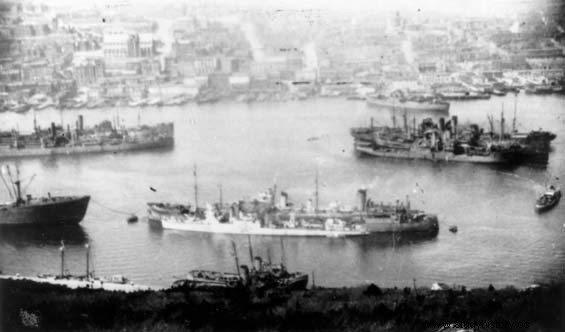One thing you may have noticed if at one time you were a student taking a history class in Canada is that textbooks seem to shine over Newfoundland and Labrador. History books mention that they voted against the Confederation, but then the future province is hardly mentioned again before it joined Canada in 1949. As some books have written it, one can almost assume that Newfoundland from 1867 to 1949 ceases to exist.
Obviously that is not the case. Newfoundland and Labrador continued as a dominion in the British Empire. But what was life like in the kingdom? How did it go through the turbulent beginning of 20 th century? But before answering these questions, go back to the beginning.
Indigenous people of Newfoundland and Labrador

It would be inappropriate to talk about the history of the colony without first mentioning the country's original inhabitants. Long before the English built permanent settlements, the territory was home to four different indigenous groups. Beothuk and Mi'kmaq lived on the island now known as Newfoundland. Innu and Inuit's traditional territory, the area is now known as Labrador.
beothuk
As noted by the Canadian Encylopedia, Beothuk traditionally lived on the coast in bark or skin-covered tents known as Wigwams and hunted fish and other coastal mammals. In the winter, Beothuk swapped its Wigwams for partially underground homes to keep warm. The establishment of permanent settlements by European colonists in the 18th century caused chaos in Beothuk's way of life. Beothuk was cut off from the coast, and had to live in inhospitable areas of the interior. The colonists also brought with them diseases that greatly decimated the Beothuk population. The last known Beothuk, Shawnadithit, died of tuberculosis in 1829. Before her death, Shawnadithit created some of the only known records of his people in St. Johns, with a description of their territory, language and customs.
Mi'kmaq
Mi'kmaq lived in the interior of the island and only went to the coast to fish in the summer. This meant that they could continue their traditional lifestyle mostly undisturbed into the 18th and 19th centuries since settlers in the area gathered around the coast, as mentioned by the Canadian Encylopedia. However, Mi'kmaq interacted with the colonists and was an ally of the French during 17 th and 18 th centuries.
Inna
Innu was traditionally nomadic and hunted a number of animals, especially the caribou. Innu used all parts of the caribou, and the animal was an important part of their faith. Innu groups in the south often communicated and traded with Europeans and were French allies. I 19 th century, the fur trade led to the hunting of the Innu countries, and they had to rely on state aid. The government forced Innu to give up his nomadic lifestyle and move to small towns.
Inuit
The Labrador Inuit are descended from Thule. Thule was a prehistoric group of talented hunters who could move great distances using leather boats and dog sleds. The Labrador Inuit lived mainly on the north coast and did not communicate much with the Europeans in the early colonial era. According to the website of the Labrador Inuit, however, Moravian missionaries in the 1760s brought about a change in the lifestyles of the Inuit, discouraging their nomadic nature. The missionaries also exposed the Inuit to disease, which led to many of the people becoming terminally ill.
Rejection of Confederation
The settler population increased significantly at the end of 18 th century and early 19th th century. The total population of Newfoundland and Labrador rose to more than 40,000. With this change came the desire for a local government to handle the island's affairs. The Newfoundlanders coveted Britain and gained both a responsible government and colonial status in 1855.
In 1864, delegates from the newly formed government in Newfoundland attended the Quebec Conference. At the conference, the thirty-three delegates from the various colonies sat down to discuss the details of a potential union. Newfoundland sent two representatives, Fredrick Carter and Ambrose Shea, exclusively in the roles of observers. The two men returned from the conference strong supporters of joining the union and became the faces of the pro-confederacy movement in Newfoundland.
However, they were faced with an uphill battle, as the movement against the Confederacy was strong. Religion played a major role in Newfoundland politics. The Protestants formed the base of the Conservative Party and the Roman Catholics the base of the Liberal Party. The majority of Catholics were of Irish descent and feared the idea of union. Ireland's union with Britain at the turn of the century had been turbulent. Newfoundland Catholics were skeptical that the same problems arose.
St. John's merchants also pushed back against the Confederacy, led by CF Bennett, a well-known merchant himself. They argued that the Confederacy would adversely affect Newfoundland's economy because tariffs would affect their exports. They also claimed that products from Canada would be so cheap that Newfoundlanders goods would be impossible to sell.
Pro-Confederates promoted the idea that Newfoundland should get new goods and services, and that being part of a larger union would attract new business to the area. Despite their arguments, the Confederate movement fought to gain followers.
Fredrick Carter became Prime Minister of Newfoundland in 1865 after the current head of state resigned. While still in favor of Confederacy, he did not want to force the public to do so. Newfoundlanders would decide in the next election. The election came in 1869, which resulted in a massive victory for CF Bennett and the side of the anti-confederation. Newfoundlanders threw a celebratory parade in the streets of St. John, and the participants carried around a false coffin marked "Confederation." While the Confederacy would occasionally be taken up again in the government afterwards, the election was ultimately the idea of the 19th anniversary. th century.
Life in Newfoundland 1855 -1900

Industry
Not surprisingly, the fishing industry was the backbone of Newfoundland's economy during 19 th century. There were two most common fishing methods:coastal and offshore. Anglers would sail to nearby fishing areas and return when their boats were full. The crew then prepared the fish, a task often performed by the fishermen's wives and children. Offshore fishermen set out a few times each season further out to sea, where they lived for several weeks at a time. The men on the boat had to prepare the catches themselves before returning to Newfoundland.
Transport
For Newfoundlanders during this period, the sea was the most important road in the colony. Newfoundland and Labrador had very few roads at this point, so instead Newfoundlanders relied almost entirely on boats. During this half of the century, steam-powered boats increased in popularity due to their efficiency. These boats would carry mail, goods, passengers and food across the coast of Newfoundland and Labrador.
The Newfoundlanders were given a new choice of transport with the construction of a railway at the end of the century. It ran through the interior of the island, with the main line connecting St.Johns with Port Aux Basques. Isolated cities were more connected than ever before. The railway line was able to transport both goods and people, and it helped to initiate the changes of 20 th century to Newfoundland.
Education
Like the political sphere, the education system was divided into two Protestants and Catholics. An education grant from the Newfoundland government provided most of the funding to schools, divided between Catholics and both Protestant Anglicans and Methodists.
The responsibility for education fell mainly on the churches, with the government doing little more than raising funds and sporadic changes in the county's education law. Each of the denominations opened as many schools as possible to reach the most children, which caused teachers' salaries to fall steadily.
There were no opportunities for upper secondary education in Newfoundland in 19 th century. Instead, the Council of Higher Education (CHE) in Newfoundland had agreements with institutes in other countries that encouraged students to apply. The students were required to write a joint exam, and if they succeeded, they could go to a foreign university. However, the exam was difficult, and the students had to study well if they wanted a chance to succeed.
Life in Newfoundland, 1900-1918

While the fishing industry was still the backbone of Newfoundland and Labrador, the new century provided new opportunities. Businesses began to set up paper mills and mines in the interior of Newfoundland, and bustling cities began to sprout around them. The new paper industry grew significantly to become an important part of the dominion's economy. The Newfoundlanders were also able to start careers that needed degrees more easily thanks to the opening of Memorial University College in 1925.
The government paved several roads, and the new inner cities were connected to the railway. According to Heritage Newfoundland and Labrador, the first car arrived on the island in 1903, when railway contractor Robert Gillespie Reid bought his Rolls Royce.
This newfound access and occupation of the island's interior proved disastrous for Mi'kmaq. The colonists almost destroyed the Caribbean population, an animal that was an important staple in the traditional Mi'kmaq diet.
World War I
As a proud British colony, Newfoundland and Labrador went to war when Britain declared war on Germany. When the Newfoundland government recruited to the First Newfoundland Regiment, they originally planned to send 500 men to Europe. They had over 900 men who applied without hesitation. With that enthusiasm, Newfoundland managed to send an entire battalion of over 1000 men instead.
The regiment would continue to make a name for itself for its bravery and skill, but not until they suffered incredible losses. The Newfoundland Regiment took part in the Battle of the Somme, a battle notorious for the number of casualties it caused. When the Newfoundland Regiment arrived at the battle, it brought over 700 men. Only 68 reported the next morning. Despite this loss, however, the regiment would continue to participate in the war with new volunteers who continued to arrive from the home front. The regiment continued to earn the title "Royal" an achievement no other unit in the British Empire would earn during the First World War.
The Great Depression and the Dissolution of Government
For Newfoundland and Labrador, the period in the late 1920s and into the 1930s was a gloomy time. There were highlights, such as a brief economic upswing in the 1920s and women gaining the right to vote in 1925. Yet the dominion's near economic ruin overshadowed everything else. The Great Depression spelled the disaster for Newfoundland. The price of exports was in free fall, and in 1933 a quarter of the population was on government aid. The government itself also had debt problems. Newfoundland had made a debt surplus after financing the regiment in the First World War and many railway and road expansion projects in the next decade.
In addition to the debt problem was the fact that the government of Newfoundland and Labrador had been unstable for almost a decade at the time. Prime Minister Richard Squire's government, which held power from 1928 to 1932, was plagued by allegations of theft from the treasury.
In 1934, Newfoundland returned to colonial status as a government commission, created by Britain, replacing the previously democratically elected one. Newfoundlanders would no longer vote to decide who was in power. Instead, Britain would choose officials to run the colony of Newfoundland to be able to support themselves again. In exchange for relinquishing control, Newfoundland and Labrador would receive financial assistance with the debt.
World War II and the Confederacy

War brought prosperity to Newfoundland and Labrador. They went to war with Britain on September 3 rd, 1939. Newfoundland was an important strategic location, and was a key player in the transatlantic flight at the time. Its air bases would be home to anti-U-boat aircraft that would accompany vital supplies and soldiers to the war front.
U.S. troops arrived in Newfoundland after Canada and the United States formed the Permanent Joint Board on Defense to protect the Western Hemisphere in 1940. New facilities arrived in Newfoundland as Americans were accustomed to having readily available leisure activities. The locals took advantage of the latest entertainment opportunities and often mingled with the Americans in the process.
The economy of Newfoundland rose sharply during the war. Newfoundlanders could easily find work at military bases. The market for fish improved significantly. The commission's government was able to invest in public infrastructure, housing, education and more. But the commission's government knew that this recovery would not last. The boom of the war would eventually fade, and the war was costly for Britain. It would not be able to support Newfoundland as long as one first thought.
Referendum
In 1948, a referendum decided the fate of Newfoundland. The Newfoundland National Convention, which consisted of 45 elected members, had for the past two years discussed what should be on the referendum. The Convention recommended to the British Government that the forms of government to be included in the ballot paper be responsible government (a return to Newfoundland's government system before 1933) and a continuation of the Commission's government. Confederates of the Convention led by Joseph Smallwood fought to add Canada to the ballot paper, but were voted out.
However, the British government announced that the confederation would be on the ballot despite the results of the convention. And with that, the campaign began in earnest.
Immediately, the anti-Confederate side ran into trouble. Their supporters were divided between two parties, and the campaign lacked leadership, funding and focus. However, they had a broad existing base of support. On the other hand, the Confederate side united under Joey Smallwood and Gordon Bradley's Confederate Association, which ran a tight campaign across the colony.
The results ended up being incredibly close. The union received 41.1 percent of the vote, followed closely by the responsible government with 44.6 percent. The Commission's government lagged behind with only 14.6 percent of the vote.
A run-off vote was called for the following month, with the commission's government taking the vote completely. The race was once again tight, but in the end the Confederacy achieved a victory.
A divisive legacy
Newfoundland and Labrador officially became a province on March 31 st , 1949. Joey Smallwood became the province's first prime minister and remained in power until 1972.
The transition to provincialism was uneven at first. One issue that was not considered was the continuation of Mi'kmaq, Innu and Labrador Inuit. There were no treaties between the indigenous people and the government and no mention of them in the terms of the confederation. Smallwood reportedly said that "There were no Indians in Newfoundland." This neglect of recognition would lead to years of legal disputes as indigenous peoples struggled to be recognized and respected.
The referendum would remain a controversial topic in the years to come. Some Newfoundlanders felt cheated out of their independence. Even today, it would not be difficult to find a Newfoundlander with a passionate attitude to the topic of the 1948 referendum.
Regardless of one person's opinion on the subject, however, everyone can agree that Newfoundland and Labrador's time as rulers have shaped the province to what it is today.
Sources used and further-reading
Bélanger, Claude. Newfoundland History - Periods of Newfoundland History, Marianopolis College, 2004, faculty.marianopolis.edu/c.belanger/nfldhistory/NewfoundlandHistory.htm.
"Labrador Inuit." Nunatsiavut Government , Nunatsiavut Government, www.nunatsiavut.com/visitors/labrador-inuit/.
"Nordic Museum." Thule culture | Museum | Museum of the North , University of Alaska, www.uaf.edu/museum/collections/archaeo/online-exhibits/paleo-eskimo-cultures/thule/.
Newfoundland Heritage Site , www.heritage.nf.ca.
The Canadian Lexicon, www.thecanadianencyclopedia.ca.
